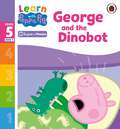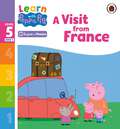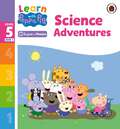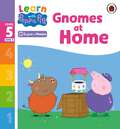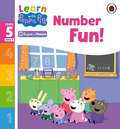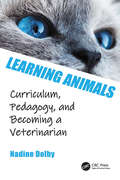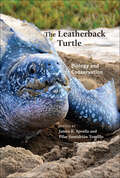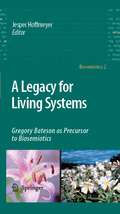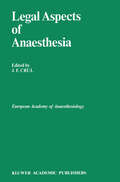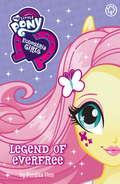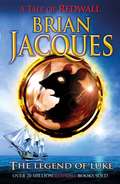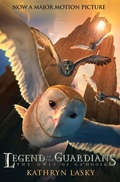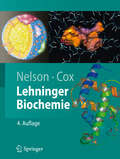- Table View
- List View
Learn with Peppa Phonics Level 5 Book 5 – George and the Dinobot (Learn with Peppa)
by Peppa PigLearn with Peppa phonics reading books provide decodable stories to take young readers from first letter sounds to phonics fluency, through five expertly graded levels.- Peppa and her friends take centre stage in this brand-new series of 70 phonics readers - Five levels of stories introduce letters and sounds in the order they are taught at school - Fun activities provide extra phonics practice and check understanding of the story - Each Learn with Peppa phonics book has been developed by educational experts - Access online audio, phonics resources and additional guidance on the Learn with Peppa websiteLet Peppa support your little ones on their early learning adventure in Learn with Peppa.Level 5 Book 5 practises known letter sounds and alternative pronunciations.Oh no! Mr Dinosaur is broken. Can George's new Dinobot save the day?
Learn with Peppa Phonics Level 5 Book 6 – A Visit from France (Learn with Peppa)
by Peppa PigLearn with Peppa phonics reading books provide decodable stories to take young readers from first letter sounds to phonics fluency, through five expertly graded levels.- Peppa and her friends take centre stage in this brand-new series of 70 phonics readers - Five levels of stories introduce letters and sounds in the order they are taught at school - Fun activities provide extra phonics practice and check understanding of the story - Each Learn with Peppa phonics book has been developed by educational experts - Access online audio, phonics resources and additional guidance on the Learn with Peppa websiteLet Peppa support your little ones on their early learning adventure in Learn with Peppa.Level 5 Book 6 practises known letter sounds and alternative pronunciations. Peppa Pig's pen pal, Delphine Donkey, is coming to stay! Will Delphine like Peppa's playschool?
Learn with Peppa Phonics Level 5 Book 7 – Science Adventures (Learn with Peppa)
by Peppa PigLearn with Peppa phonics reading books provide decodable stories to take young readers from first letter sounds to phonics fluency, through five expertly graded levels.- Peppa and her friends take centre stage in this brand-new series of 70 phonics readers - Five levels of stories introduce letters and sounds in the order they are taught at school - Fun activities provide extra phonics practice and check understanding of the story - Each Learn with Peppa phonics book has been developed by educational experts - Access online audio, phonics resources and additional guidance on the Learn with Peppa website Let Peppa support your little ones on their early learning adventure in Learn with Peppa.Level 5 Book 7 practises known letter sounds and alternative pronunciations.Daddy Pig has some fun science experiments to share - but will he learn an important lesson too?
Learn with Peppa Phonics Level 5 Book 8 – Gnomes at Home (Learn with Peppa)
by Peppa PigLearn with Peppa phonics reading books provide decodable stories to take young readers from first letter sounds to phonics fluency, through five expertly graded levels.- Peppa and her friends take centre stage in this brand-new series of 70 phonics readers- Five levels of stories introduce letters and sounds in the order they are taught at school- Fun activities provide extra phonics practice and check understanding of the story- Each Learn with Peppa phonics book has been developed by educational experts- Access online audio, phonics resources and additional guidance on the Learn with Peppa websiteLet Peppa support your little ones on their early learning adventure in Learn with Peppa.Level 5 Book 8 practises known letter sounds and alternative pronunciations.Can Peppa Pig help Granny and Grandpa Pig with their gnome problem?
Learn with Peppa Phonics Level 5 Book 9 – Number Fun! (Learn with Peppa)
by Peppa PigLearn with Peppa phonics reading books provide decodable stories to take young readers from first letter sounds to phonics fluency, through five expertly graded levels.- Peppa and her friends take centre stage in this brand-new series of 70 phonics readers - Five levels of stories introduce letters and sounds in the order they are taught at school - Fun activities provide extra phonics practice and check understanding of the story - Each Learn with Peppa phonics book has been developed by educational experts - Access online audio, phonics resources and additional guidance on the Learn with Peppa website Let Peppa support your little ones on their early learning adventure in Learn with Peppa.Level 5 Book 9 practises known letter sounds and alternative pronunciations.Madame Gazelle shows Peppa Pig and her friends that numbers are used for more than just counting!
Learning Animals: Curriculum, Pedagogy and Becoming a Veterinarian
by Nadine DolbyWe are surrounded by thousands of animals, alive and dead. They are an intimate and ever-present part of our human lives. As a society, we privilege veterinarians as experts on these animals: they are our educators and teachers in what they say, what they do, and the decisions that they make. Yet, within the field of education, there is little research on the curriculum, pedagogy, and experiences of veterinary school and students. What do veterinarians learn in veterinary school? How do their experiences during those four years shape their perceptions of animals? How do the structures, curriculum, and pedagogy of veterinary college create and influence these experiences? Learning Animals opens up this conversation through an exploration of the complicated, fascinating and often painful stories of a cohort of veterinary students as they make their four-year journey from matriculation through graduation. The book examines how the experiences of veterinary students shape how humans relate to animals, from public policy and decision-making about the environment and animals slaughtered for food, to the most personal decisions about euthanizing companion animals. The first full-length, critical, qualitative study of the perspectives of our primary teachers about animals, this will be a thought-provoking read for those in the fields of both educational research and veterinary education.
Learning Animals: Curriculum, Pedagogy and Becoming a Veterinarian
by Nadine DolbyWe are surrounded by thousands of animals, alive and dead. They are an intimate and ever-present part of our human lives. As a society, we privilege veterinarians as experts on these animals: they are our educators and teachers in what they say, what they do, and the decisions that they make. Yet, within the field of education, there is little research on the curriculum, pedagogy, and experiences of veterinary school and students. What do veterinarians learn in veterinary school? How do their experiences during those four years shape their perceptions of animals? How do the structures, curriculum, and pedagogy of veterinary college create and influence these experiences? Learning Animals opens up this conversation through an exploration of the complicated, fascinating and often painful stories of a cohort of veterinary students as they make their four-year journey from matriculation through graduation. The book examines how the experiences of veterinary students shape how humans relate to animals, from public policy and decision-making about the environment and animals slaughtered for food, to the most personal decisions about euthanizing companion animals. The first full-length, critical, qualitative study of the perspectives of our primary teachers about animals, this will be a thought-provoking read for those in the fields of both educational research and veterinary education.
Learning from Disease in Pets: A ‘One Health’ Model for Discovery (CRC One Health One Welfare)
by Rebecca A. KriminsLearning from Disease in Pets: A ‘One Health’ Model for Discovery is the first encompassing reference guide for veterinarians, researchers and physicians on conducting studies using spontaneous models of disease in animals. The study of naturally occurring disease in (pet) animals can help model our understanding of the biology, prevention and therapy of human and animal diseases. Studies of pet dogs, for instance, can aid treatment of complex medical problems such as cancer, orthopedic, cardiopulmonary, and neuro-inflammatory diseases, and zoonotic infections. Each chapter within this novel cross-species approach is contributed by a leader, or leaders, in their field of research. Using clinical trials to learn how pets with real diseases respond to therapy can lead to breakthroughs in human medicine, as well as benefiting pets suffering from otherwise debilitating illness. Despite similarities of diseases across species, there are very few spontaneous models of disease used in research compared with models where disease is induced in healthy laboratory animals. Many medical researchers and veterinarians have a multitude of questions regarding how to use naturally occurring diseases in pets for the discovery of treatments and diagnostics: this book will demonstrate how to safely make this happen. This book encourages veterinarians to build on and disseminate existing findings for the wider benefit of pets and humans. Many pets suffering from incurable illnesses may benefit from clinical trials; the book includes a section on the imperative communication styles necessary within the research environment and with clients, a compelling discussion on the ethics of using pets in veterinary clinical research, comprehensive tables of diseases that spontaneously occur in animals and humans, the regulatory requirements necessary to move therapy from benchside research to patient bedside, as well as intricate details on how to design a robust clinical study.
Learning from Disease in Pets: A ‘One Health’ Model for Discovery (CRC One Health One Welfare)
by Rebecca A. KriminsLearning from Disease in Pets: A ‘One Health’ Model for Discovery is the first encompassing reference guide for veterinarians, researchers and physicians on conducting studies using spontaneous models of disease in animals. The study of naturally occurring disease in (pet) animals can help model our understanding of the biology, prevention and therapy of human and animal diseases. Studies of pet dogs, for instance, can aid treatment of complex medical problems such as cancer, orthopedic, cardiopulmonary, and neuro-inflammatory diseases, and zoonotic infections. Each chapter within this novel cross-species approach is contributed by a leader, or leaders, in their field of research. Using clinical trials to learn how pets with real diseases respond to therapy can lead to breakthroughs in human medicine, as well as benefiting pets suffering from otherwise debilitating illness. Despite similarities of diseases across species, there are very few spontaneous models of disease used in research compared with models where disease is induced in healthy laboratory animals. Many medical researchers and veterinarians have a multitude of questions regarding how to use naturally occurring diseases in pets for the discovery of treatments and diagnostics: this book will demonstrate how to safely make this happen. This book encourages veterinarians to build on and disseminate existing findings for the wider benefit of pets and humans. Many pets suffering from incurable illnesses may benefit from clinical trials; the book includes a section on the imperative communication styles necessary within the research environment and with clients, a compelling discussion on the ethics of using pets in veterinary clinical research, comprehensive tables of diseases that spontaneously occur in animals and humans, the regulatory requirements necessary to move therapy from benchside research to patient bedside, as well as intricate details on how to design a robust clinical study.
Learning the Birds: A Midlife Adventure
by Susan Fox Rogers"The thrill of quiet adventure. The constant hope of discovery. The reminder that the world is filled with wonder. When I bird, life is bigger, more vibrant." That is why Susan Fox Rogers is a birder. Learning the Birds is the story of how encounters with birds recharged her adventurous spirit. When the birds first called, Rogers was in a slack season of her life. The woods and rivers that enthralled her younger self had lost some of their luster. It was the song of a thrush that reawakened Rogers, sparking a long-held desire to know the birds that accompanied her as she rock climbed and paddled, to know the world around her with greater depth. Energized by her curiosity, she followed the birds as they drew her deeper into her authentic self, and ultimately into love. In Learning the Birds, we join Rogers as she becomes a birder and joins the community of passionate and quirky bird people. We meet her birding companions close to home in New York State's Hudson Valley as well as in the desert of Arizona and awash in the midnight sunlight of Alaska. Along on the journey are birders and estimable ornithologists of past generations—people like Franklin Delano Roosevelt and Florence Merriam Bailey—whose writings inspire Rogers's adventures and discoveries. A ready, knowledgeable, and humble friend and explorer, Rogers is eager to share what she sees and learns. Learning the Birds will remind you of our passionate need for wonder and our connection to the wild creatures with whom we share the land.
The Leatherback Turtle: Biology and Conservation
by James R. Spotila Pilar Santidrián TomilloWeighing as much as 2,000 pounds and reaching lengths of over seven feet, leatherback turtles are the world’s largest reptile. These unusual sea turtles have a thick, pliable shell that helps them to withstand great depthsâ€�they can swim more than one thousand meters below the surface in search of food. And what food source sustains these goliaths? Their diet consists almost exclusively of jellyfish, a meal they crisscross the oceans to find. Leatherbacks have been declining in recent decades, and some predict they will be gone by the end of this century. Why? Because of two primary factors: human redevelopment of nesting beaches and commercial fishing. There are only twenty-nine index beaches in the world where these turtles nest, and there is immense pressure to develop most of them into homes or resorts. At the same time, longline and gill net fisheries continue to overwhelm waters frequented by leatherbacks. In The Leatherback Turtle, James R. Spotila and Pilar Santidrián Tomillo bring together the world’s leading experts to produce a volume that reveals the biology of the leatherback while putting a spotlight on the conservation problems and solutions related to the species. The book leaves us with options: embark on the conservation strategy laid out within its pages and save one of nature’s most splendid creations, or watch yet another magnificent species disappear.
Leaving Space for Nature: The Critical Role of Area-Based Conservation (Routledge Studies in Conservation and the Environment)
by Nigel Dudley Sue StoltonThis book provides the first contemporary assessment of area-based conservation and its implications for nature and society. Now covering 15 per cent of the land surface and a growing area of ocean, the creation of protected areas is one of the fastest conscious changes in land management in history. But this has come at a cost, including a backlash from human rights organisations about the social impacts of protected areas. At the same time, a range of new types of area-based conservation has emerged, based on indigenous people’s territories, local community lands and a new designation of “other effective area-based conservation measures”. This book provides a concise overview of the status and possible futures of area-based conservation. With many people calling for half the earth’s land surface to remain in a natural condition, this book taps into the urgent debate about the feasibility of such an aim and the ways in which such land might be managed. It provides a timely contribution by people who have been at the centre of the debate for the last twenty years. Building on the authors’ large personal knowledge, the book draws on global case studies where the authors have firsthand experience, including Yosemite National Park (USA), Blue Mountains National Park (Australia), Bwindi National Park (Uganda), Chingaza National Park (Colombia), Ustyart Plateau (Kazakhstan), Snowdonia National Park (Wales) and many more. This book is essential reading for students, academics and practitioners interested in conservation and its impact on society.
Leaving Space for Nature: The Critical Role of Area-Based Conservation (Routledge Studies in Conservation and the Environment)
by Nigel Dudley Sue StoltonThis book provides the first contemporary assessment of area-based conservation and its implications for nature and society. Now covering 15 per cent of the land surface and a growing area of ocean, the creation of protected areas is one of the fastest conscious changes in land management in history. But this has come at a cost, including a backlash from human rights organisations about the social impacts of protected areas. At the same time, a range of new types of area-based conservation has emerged, based on indigenous people’s territories, local community lands and a new designation of “other effective area-based conservation measures”. This book provides a concise overview of the status and possible futures of area-based conservation. With many people calling for half the earth’s land surface to remain in a natural condition, this book taps into the urgent debate about the feasibility of such an aim and the ways in which such land might be managed. It provides a timely contribution by people who have been at the centre of the debate for the last twenty years. Building on the authors’ large personal knowledge, the book draws on global case studies where the authors have firsthand experience, including Yosemite National Park (USA), Blue Mountains National Park (Australia), Bwindi National Park (Uganda), Chingaza National Park (Colombia), Ustyart Plateau (Kazakhstan), Snowdonia National Park (Wales) and many more. This book is essential reading for students, academics and practitioners interested in conservation and its impact on society.
Leaving the Lyrebird Forest
by Gary Crew'Are you lonely here?' her mother asked. 'Never,' Alice said. 'Not while I am friends with the lyrebird.'Alice has spent her life living on the outskirts of a small town, in a house nestled in bushland. Every other morning, she is visited by a lyrebird. Her bond with this magnificent bird brings her together with her nearest neighbour, Mr Brown, a widower who loves the bush and its treasures as much as she does.But change is coming: Alice is growing up, and having to think about her future (a future which might mean leaving the bush for her education). Mr Brown is getting older, and less able to look after himself. And as the nearby town grows, their beloved lyrebird and bushland are threatened too.A touching story that will resonate with readers everywhere, stunningly illustrated with woodcuts by acclaimed artist Julian Laffan.
Leaving Time: the impossible-to-forget story with a twist you won’t see coming by the number one bestselling author of A Spark of Light
by Jodi PicoultTHE SUNDAY TIMES BESTSELLER'It's hard to exaggerate how well Picoult writes' Financial TimesTen years ago, Alice Metcalf vanished after a car accident, leaving her daughter Jenna to grow up grappling with the mystery of her disappearance. Jenna has never believed that her mother could have simply left her. Determined to uncover the truth of what happened to Alice, she sets out to retrace the events of that fateful night. But nothing can prepare her for the answers that await.'An addictive read packed with twists and turns' Closer
Leben ohne Fernsehen: Eine qualitative Nichtfernseherstudie (DUV Sozialwissenschaft #2)
by Peter SickingDer Autor entwickelt eine datengestützte Typologie, die einen differenzierten Blick auf die Nichtfernseher erlaubt und Rückschlüsse auf die gesellschaftliche Verteilung der unterschiedlichen Nichtfernseher zuläßt.
Lebensmittelmikrobiologie: Grundlagen für die Praxis
by Klaus PichhardtPrüfungen und Kontrollanalysen zur Beurteilung der mikrobiologischen Beschaffenheit von Nahrungsmitteln nehmen in allen Lebensmittelbetrieben eine zentrale Stellung in der Qualitätssicherung ein. Im vorliegenden Leitfaden werden alle Routineverfahren zur Durchführung von Laborkontrollen ausführlich beschrieben. Detaillierte Arbeitsanleitungen mit genauen Rezepturen, praktische Hinweise sowie Stichprobenpläne und umfangreiche Tabellen zu Keimzahlnormen erlauben es, die Untersuchungsmethoden direkt im Labor nachzuarbeiten und Ergebnisse zu interpretieren. Die überarbeitete 4. Auflage wurde durch das HACCP-Konzept und weitere Themen ergänzt, um der im Februar 1998 in Kraft tretenden bundeseinheitlichen Lebensmittelhygiene-Verordnung (LMHV) Rechnung zu tragen.
Leeches, Lice and Lampreys: A Natural History of Skin and Gill Parasites of Fishes
by Graham C. KearnMany different kinds of animals have adopted a parasitic life style on the skin and gills of marine and freshwater fishes, including protozoans, flatworms, leeches, a range of crustaceans and even some vertebrates (lampreys). There is a parasitic barnacle, described first in the 19th century by Charles Darwin, fish lice that change sex and bivalve molluscs parasitic only when young. This book explores for the first time in one volume, the remarkable biology of these little known and frequently bizarre animals. The following closely interwoven themes are considered for each group of parasites: how they find their hosts, how they attach, feed and reproduce, the damage they inflict and how the host’s immune system retaliates. Based on the British fauna, but extending where appropriate to examples from North America, Australia and elsewhere, the book is essential reading, not just for the professional parasitologist, but also for anyone interested in fishes and in this neglected field of British natural history. With the enquiring naturalist in mind, terms and concepts are explained as they arise, backed up by a glossary, and the text is liberally illustrated. An introductory chapter on fish biology sets the scene and common fish names are used throughout, as well as scientific names.
A Legacy for Living Systems: Gregory Bateson as Precursor to Biosemiotics (Biosemiotics #2)
by Jesper HoffmeyerGregory Bateson’s contribution to 20th century thinking has appealed to scholars from a wide range of fields dealing in one way or another with aspects of communication and epistemology. A number of his insights were taken up and developed further in anthropology, psychology, evolutionary biology and communication theory. But the large, trans-disciplinary synthesis that, in his own mind, was his major contribution to science received little attention from the mainstream scientific communities. This book represents a major attempt to revise this deficiency. Scholars from ecology, biochemistry, evolutionary biology, cognitive science, anthropology and philosophy discuss how Bateson's thinking might lead to a fruitful reframing of central problems in modern science. Most important perhaps, Bateson's bioanthropology is shown to play a key role in developing the set of ideas explored in the new field of biosemiotics. The idea that organismic life is indeed basically semiotic or communicative lies at the heart of the biosemiotic approach to the study of life. The only book of its kind, this volume provides a key resource for the quickly-growing substratum of scholars in the biosciences, philosophy and medicine who are seeking an elegant new approach to exploring highly complex systems.
Legal Aspects of Anaesthesia (Developments in Critical Care Medicine and Anaesthesiology #21)
by J. F. CrulJ.F. Crul The topic Legal Aspects of Anaesthesia is still rarely treated in book publications, but deserves increasing attention as more cases of litigation occur each year and anaesthetists also become more aware of the legal structure within which they practice their profession. I am happy to have been able to obtain the cooperation of experts in this field from various European countries. The contributing authors in this book come from both the anaesthesia and surgery side as well as from the jurisprudential background. As these two fields have their own professional jargon we have been very careful in using definitions, avoiding that a specific term might lead to misunderstanding and confusion. The international authorship did not facilitate this task. The subject of this book was also the topic of a meeting of the European Academy of Anaesthesiology held at the French Study Center, La Suquette, Saint Vincent Ie Palue~ held three years before publication of this book. The organizers G. Barrier, J.F. Crul, and J. Lassner felt the need for a book publication presenting the state of the art of anaesthesia and the law in European countries. With the present book this plan has been realized. During the meeting many subjects were thoroughly discussed and the editor considered a number of them as very informative and therefore these were included in this book.
Legend of Everfree: My Little Pony (My Little Pony #7)
by Perdita Finn My Little PonyIn the human world, far from Equestria, there are some very familiar girls. Meet Pinkie Pie, Rainbow Dash and all their freinds as you've never seen them before! The Equestria Girls are off on their summer holidays to Camp Everfree, but the camp is in danger of closing down! Can Fluttershy and her friends pony up and throw a fundraising show in time to save their summer? And what is the mysterious legend of Everfree?
The Legend of Luke: A Tale From Redwall (Redwall #12)
by Brian JacquesA chance meeting with a young hedgehog maid who is visiting Redwall Abbey reveals to Martin the Warrior a tantalising glimpse of the early life, and family, he can scarcely remember. He sets forth from the Abbey to seek the truth about the father he barely knew, accompanied by his trusty friends Dinny, Trimp and Gonff. His journey takes him home to the northland shore, meeting friends and enemies, old and new, along the way and leading him to an extraordinary shipwreck. The wreck, the Arfship, is home to three ancient, veteran warriors who have in their possession a dusty old volume. Inside is the story of Martin's early life and the dramatic account of his father Luke's pursuit of his hated enemy, the pirate stoat, Vilu Daskar. Brian Jacques' skilful narrative is told in three parts, interweaving the stories of father and son in yet another unforgettable Redwall experience.
LEGEND OF THE GUARDIANS: The Owls Of Ga'hoole
by Kathryn LaskyNow a major motion picture!Enter the world of the owls and meet the heroes who keep it safe…
Legion: Talon Rogue Soldier Legion (The Talon Saga #4)
by Julie KagawaFrom the New York Times, and international bestselling author of The Iron Fey and the Blood of Eden series comes the fourth instalment of The Talon Saga… The legions will be unleashed. No-one can stand against the coming horde…
Lehninger Biochemie (Springer-Lehrbuch)
by David Nelson Michael CoxSeit einem Vierteljahrhundert setzt der „Lehninger“ Maßstäbe als Lehrbuch der Biochemie - mit einer klaren Sprache, sorgfältigen Illustrationen, spannenden Exkursen und Beispielen aus der aktuellsten Forschung. So werden in der neuen Auflage sowohl die Grundlagen betont als auch der Reiz der aktuellen Forschung und ihrer Perspektiven vermittelt. Neben den neuesten Fortschritten und neuen Methoden in der Biochemie wurden noch mehr medizinisch relevante Beispiele aufgenommen. Ein Schwerpunkt der neuen Auflage, der sich über alle relevanten Kapitel verteilt, ist Diabetes. Über 100 neue Aufgaben am Ende der Kapitel bieten den Studierenden die Möglichkeit, das Gelernte einzuüben. Dieses Buch ist die Übersetzung der 5. amerikanischen Auflage.
